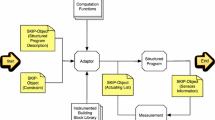Abstract
Skeleton/template based programming models allow performance prediction of parallel applications to be performed by exploiting the analytical performance models associated to the implementation templates. In this work, we present a software tool (P3L-prof) that supports programmers using skeleton/template programming based languages in the performance debugging/tuning of parallel applications. P3L-prof allows different “structures” (skeleton compositions) of a parallel application to be evaluated with respect to their expected performance onto a given target architecture before the application is actually coded and run. It also allow programmers to compare the expected performances on different target architectures in such a way that the “best performing” one can be individuated.
This work has been partially supported by the 40% MURST program.
Preview
Unable to display preview. Download preview PDF.
Similar content being viewed by others
References
B. Bacci, M. Danelutto, S. Orlando, S. Pelagatti, and M. Vanneschi. P3L: A Structured High level programming language and its structured support. Concurrency Practice and Experience, 7(3):225–255, May 1995.
A. Ceccolini and G. Orsini. Uno strumento per il supporto alla programmazione parallela strutturata. Graduation thesis at the Dept. of Computer Science — University of Pisa, June 1995.
M. I. Cole. A “Skeletal” Approach to Exploitation of Parallelism. In C. R. Jesshope and K. D. Reinartz, editors, CONPAR 88, British Computer Society Workshop Series. Cambridge University Press, 1989.
M. Danelutto, R. Di Meglio, S. Orlando, S. Pelagatti, and M. Vanneschi. A methodology for the development and support of massively parallel programs. Future Generation Computer Systems, 8(1–3), July 1992.
J. Darlington, A. J. Field, P.G. Harrison, P. H. J. Kelly, D. W. N. Sharp, Q. Wu, and R. L. While. Parallel Programming Using Skeleton Functions. In M. Reeve A. Bode and G. Wolf, editors, PARLE'93 Parallel Architectures and Langauges Europe. Springer Verlag, June 1993. LNCS No. 694.
J. Darlington, Y. Guo, H. W. To, Q. Wu, J. Yang, and M. Kohler. Fortran-S: A Uniform Functional Interface to Parallel Imperative Languages. In Third Parallel Computing Workshop (PCW'94). Fujitsu Laboratories Ltd., November 1994.
J. Darlington, Y. Guo, H. W. To, and J. Yang. Parallel Skeletons for Structured Composition. In Fifth ACM SIGPLAN Symposium on Principles and Practice of Parallel Programming. ACM Press, July 1995.
K. M. Decker and R. M. Rehmann Editors. Programming Environments for Massively Parallel Distributed Systems. Birkhauser, 1994.
P. Newton and J. C. Browne. The CODE 2.0 Graphical Parallel Programming Language. In Proceedings of ACM International Conference on Supercomputing, July 1992.
J. K. Ousterhout. Tcl and the Tk toolkit. Addison. Wesley, 1993.
S. Pelagatti. A methodology for the development and the support of massively parallel programs. Technical Report TD-11/93, Dept. of Computer Science-Pisa, 1993. PhD Thesis.
J. Shaffer, D. Szafron, G. Lobe, and I. Parson. The Enterprise Model for Developing Distributed Applications. IEEE Parallel and Distributed Technology, 1(3):85–96, 1993.
Author information
Authors and Affiliations
Editor information
Rights and permissions
Copyright information
© 1996 Springer-Verlag Berlin Heidelberg
About this paper
Cite this paper
Ceccolini, A., Danelutto, M., Orsini, G., Pelagatti, S. (1996). A tool for the development of structured parallel applications. In: Liddell, H., Colbrook, A., Hertzberger, B., Sloot, P. (eds) High-Performance Computing and Networking. HPCN-Europe 1996. Lecture Notes in Computer Science, vol 1067. Springer, Berlin, Heidelberg. https://doi.org/10.1007/3-540-61142-8_587
Download citation
DOI: https://doi.org/10.1007/3-540-61142-8_587
Published:
Publisher Name: Springer, Berlin, Heidelberg
Print ISBN: 978-3-540-61142-4
Online ISBN: 978-3-540-49955-8
eBook Packages: Springer Book Archive





